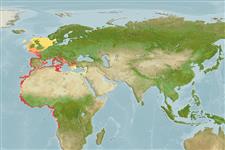Classification / Names
Common names from other countries
Main reference
Size / Weight / Age
Max length : 130 cm FL male/unsexed; (Ref. 168); common length : 90.0 cm FL male/unsexed; (Ref. 168); max. published weight: 13.1 kg (Ref. 168)
Length at first maturity
Lm ?, range 70 - 80 cm
Environment
Marine; brackish; pelagic-neritic; oceanodromous (Ref. 51243)
Climate / Range
Subtropical, preferred 19°C (Ref. 107945); 60°N - 13°S, 18°W - 36°E
Distribution
Eastern Atlantic: Oslo, Norway south to Dakar, Senegal but the range is centered in the southern Mediterranean Sea. Not known from Madeira, the Canary Islands or Cape Verde.
Countries | FAO areas | Ecosystems | Occurrences | Introductions
Short description
Dorsal
spines
(total): 12 - 14;
Dorsal
soft rays
(total): 12-15;
Anal
soft rays: 14 - 16. Mouth rather large, upper jaw reaching to hind margin of eye. Laminae of olfactory rosette 25 to 28. Interpelvic process small and bifid. Body naked behind the well developed corselet. Swim bladder absent. Vertebrae 17 or 18 precaudal plus 19 to 21 caudal, total 37 to 39. Anterior three quarters of first dorsal fin black.
IUCN Red List Status (Ref. 115185)
Threat to humans
Harmless
Human uses
Fisheries: minor commercial; gamefish: yes
More information
ReferencesAquacultureAquaculture profileStrainsGeneticsAllele frequenciesHeritabilityDiseasesProcessingMass conversion
Tools
Special reports
Download XML
Internet sources
Estimates of some properties based on models
Phylogenetic diversity index
PD50 = 1.0000 many relatives (e.g. carps) 0.5 - 2.0 few relatives (e.g. lungfishes)
Trophic Level
4.5 ±0.80 se; Based on food items.
Resilience
Medium, minimum population doubling time 1.4 - 4.4 years (Assuming tm<=4)
Vulnerability
High vulnerability (61 of 100)
Price category
